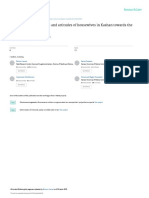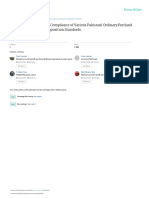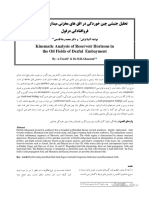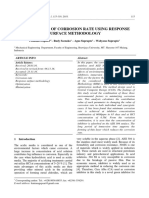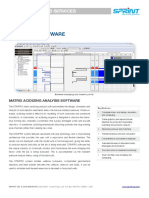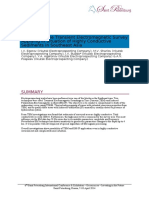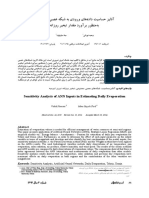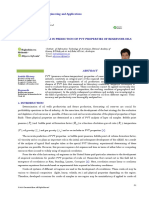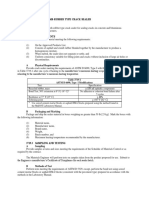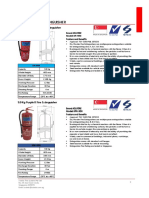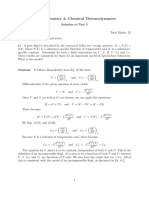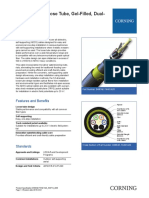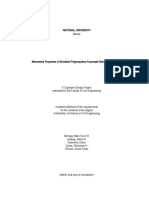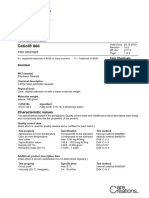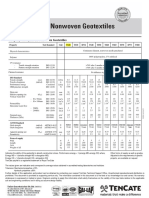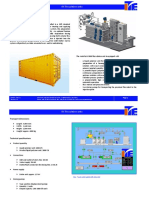EAGE 2017 Paris
Uploaded by
sina giahkarEAGE 2017 Paris
Uploaded by
sina giahkarSee discussions, stats, and author profiles for this publication at: https://www.researchgate.
net/publication/317549683
Candidate Well Selection for Hydraulic Fracturing Treatment - New Fracability
Index Based on a Case Study in a Fractured Carbonate Reservoir in Iran
Conference Paper · June 2017
DOI: 10.3997/2214-4609.201701438
CITATIONS READS
0 706
3 authors:
Hamed Amiri Ahmad Ramezanzadeh
Utrecht University Shahrood University of Technology
2 PUBLICATIONS 10 CITATIONS 41 PUBLICATIONS 211 CITATIONS
SEE PROFILE SEE PROFILE
Mohammad reza Parhizgar
National Iranian South Oil Company
1 PUBLICATION 0 CITATIONS
SEE PROFILE
Some of the authors of this publication are also working on these related projects:
Stability Analysis of Natural Gas Storage in Salt Caverns View project
ﻣﻐﺎر ذﺧﻴﺮه ﺳﺎزي ﺑﻨﺪر ﮔﻨﺎوه: ﻣﻄﺎﻟﻌﻪ ﻣﻮردي، ﺗﺤﻠﻴﻞ ﭘﺎﻳﺪاري و ﻃﺮاﺣﻲ ﺳﻴﺴﺘﻢ ﻧﮕﻬﺪاري ﻣﻐﺎر ذﺧﻴﺮه ﺳﺎزي ﻧﻔﺖ ﺧﺎم، ﻃﺮاﺣﻲ ﻫﻨﺪﺳﻲView project
All content following this page was uploaded by Hamed Amiri on 20 December 2017.
The user has requested enhancement of the downloaded file.
Introduction
Hydraulic fracturing is a well-known and one of most conventional and economic stimulation
methods for enhancing hydrocarbon production and recovery factor in low permeability and damaged
reservoirs. Formation damage which is occurred by several mechanism such as drilling operation,
sand production and previous matrix acidizing operation, is a prevalent problem in carbonate
reservoirs of Iran. In order to resolve this problem which lower the level of hydrocarbon production
considerably, hydraulic fracturing treatment has to be performed (Zoveidanvianpour et al, 2012). In
the process of hydraulic fracturing, injection of fluid into the well continue until the formation breaks
down and a double wing fracture will be created (Economides and Notle, 2000).
The extensive efforts consist of geomechanical studies, performing wellbore integrity tests (leak-off
test, calibration test, etc.) should be made to perform the operation successfully. Moreover, candidate
selection studies play a key role and any neglect in this context will result in failure of whole
operation. Main objective in the candidate selection is to choose the best wells and layers that not only
need to a less fracture initiation pressure, but also can improve hydrocarbon production as much as
possible (Hashemi et al, 2012).
In recent years, term of “fracability” has been used frequently in selecting hydraulic fracturing
candidates in shale and sandstone reservoirs. However, there is no universal method for evaluating the
fracability even in shale reservoirs. Generally, in different oil and gas reservoirs, fracability index is
defined by understanding the failure mechanism, geological and geomechanical background and most
important factors that could affect the fracability results (Zhang et al, 2015; Fu et al, 2015; Guo et al,
2015; Fang and Amro, 2014; Mullen and Enderlin, 2012).
Candidate well/layer selection
The topic of candidate selection is one of challenging task in various fields of engineering, especially
in oil and gas industry that cost of some operations like hydraulic fracturing is high. In such situation,
selection of inappropriate candidates can result in waste of time and investment. Propagation of the
fracture to surrounding layers, need for high pressure to create the fracture, weak fracture conductivity
because of high stress applied on fracture faces and losing fracturing fluid are some consequences of
poor candidate selection (Heydarabadi et al, 2010).
In this study, different layers of Ilam and Sarvak formations in a carbonate reservoir located in
southwest of Iran have been evaluated in three steps:
1) Based on literature review and available data, the most important factors and criteria for
selecting candidate wells and layers are specified.
2) A new fracability index, total fracability index (TFI), is presented in order to screen out
different zones and identify the layers that have potential to be selected for further analysis.
3) Selecting candidate layers in three well using analytic hierarchy process (AHP) and based on
total fracability index, natural fracture index, fracture containment and thickness as four main
criteria.
Criteria
Choosing of appropriate factors and criteria has an important role in the process of candidate
selection. This is done based on previous studies and field experiences. Studies show that in carbonate
reservoir, occurrence of two problems are common; multiple fracture due largely to existence of
natural fractures and screen out phenomenon as a result of high Young’s modulus in the layer as well
(Hashemi et al 2012).
In this paper a new fracability calculation model, suitable for carbonate reservoir, is proposed. This
fracability index integrates Young’s modulus, brittleness, internal friction angle, magnitude of
minimum horizontal stress and horizontal stress contrast. Formation with higher FI are selected for
further analysis. At the end, four main criteria consist of fracability index, natural fracture index
(NFI), layer thickness, and fracture containment are evaluated in different layers based on analytic
hierarchy process (AHP) model and candidate layers are selected.
79th EAGE Conference & Exhibition 2017
Paris, France, 12-15 June 2017
Total fracability index (TFI)
In recent years, the term of fracability has been used frequently to select best candidates for hydraulic
fracturing operation. This term shows that hydraulic fracturing in a certain reservoir how can be easy
and effective. In general, common approach to derive an equation for calculating of fracability in a
specific oil and gas reservoir is to understand failure mechanism of hydraulic fracturing based on
geomechanical background. Furthermore, most effective geomechanical parameters should be
identified and, at the end, an appropriate fracability calculation method will be presented. Therefore, it
could be said that fracability merges effective factors and parameters into one index (Zhang et al
2015).
Containment of fracture
Containment of fracture is an answer to this question: “whether initiated hydraulic fracture will
propagate in the candidate layer or not?”. In other word, adjacent layers or zones to the interested
zone should be capable of preventing hydraulic fracturing from propagating vertically. This can make
some problems that will have deleterious effects on operation results such as water production as a
result of propagating to a layer with high water saturation (Heydarabadi et al, 2010).
Fracture containment capacity, generally, is determined by minimum horizontal stress contrast
between candidate layer and adjacent layers. However, another mechanisms such as difference in
elastic and strength properties have an effective role in put a stop to further propagation. When
magnitude of these parameters in surrounding layers is greater than the interested layer, we can expect
that growth of fracture will end (Sarmadivaleh and Rasouli, 2010; Economides and Notle, 2000). In
this paper, in order to evaluate the fracture containment, reservoir classified into 8 geomechanical
units (GMUs) based on Young’s modulus values. How much Young’s modulus is higher, number of
GMU is more.
Interaction between HF and natural fractures
When hydraulic fracture propagates and arrives at a natural fracture (figure 1) whereby approach
angle between them, three scenario may be occurred (Zanganeh et al, 2014):
1) Cross; in this scenario, hydraulic fracture crosses the natural fracture with no change in its
direction.
2) Offset; this scenario occurs when the hydraulic fracture cannot cross the natural fracture, but,
injection pressure is high enough to reinitiate it in direction of natural fracture.
3) Arrest; in this situation, injection pressure is less than the pressure required for crossing the
natural fracture. Therefore, hydraulic fracture will be arrested after that it arrives at a natural
fracture.
Figure 1 Interaction between hydraulic fracture and a natural fracture (Zanganeh et al, 2014)
79th EAGE Conference & Exhibition 2017
Paris, France, 12-15 June 2017
Occurrence of each one of these scenarios depends on angle of approach and differential in situ
stresses. Effect of these parameters on the interaction has been studied by several researchers. Results
of laboratory experiments and numerical simulations show that when approach angle is 60 degrees or
higher and differential stress is high (usually higher than 10Mpa), hydraulic fracture will cross a pre-
existing fracture. In addition, with approach angle of less than 30 degrees and low stress contrast,
second scenario (offset) is more likely to occur. Finally, when approach angel is around 45 degrees
and stress contrast is intermediate, propagation of fracture stop and effectiveness of operation
decrease consequently (Zanganeh et al, 2014; Aghighi et al, 2010; Zhou et al, 2008; Taleghani and
Olson, 2014).
In this paper, geomechanical model in the studied wells consist of elastic and strength properties,
magnitude and direction of in situ stresses in the wells was constructed. In addition, orientation of
natural fractures was determined by using the analysis of image logs. Then, based on results of
mentioned studies, interaction between hydraulic fracture and natural fractures was evaluated and
used as one of main criteria.
Results and conclusion
In this study, a new fracability index namely total fracability index (TFI), was introduced. This index
increases when Young’s modulus, minimum horizontal stress and internal friction angle decrease. On
other hand, an increase in brittleness and horizontal stress contrast will increase it. Then, by using the
AHP method, this index and three other criteria were evaluated in various layers in three well in a
fractured carbonate reservoir in Iran. Results in an interval in Sarvak formation and in the zones E1
and E2 of well B have been shown in figure 2.
Candidate 2
Candidate 1
Candidate 3
Figure 2 selected candidates in the Sarvak formation, layers E1 and E2
79th EAGE Conference & Exhibition 2017
Paris, France, 12-15 June 2017
In this figure, depth (m), corrected gamma ray (GAPI), Young’s modulus (Gpa), clay content,
brittleness, TFI, GMU and lithology are shown in tracks 1 to 8, respectively. As can be seen, value of
TFI is relatively high in the three candidates. In this formation, layer E2 (from 3659m to 3683m),
layer E1 (from 3589m to 3608m) and layer E2 (from 3700m to 3723m) are selected as first three
candidates. These candidates have proper containment according to GMU values in adjacent layers.
In Ilam formation, on other hand, layer C1 in well B, layer C1 in well A and layer C2 in well B are
best candidates, respectively.
References
Aghighi, M.A., Rahman, M.M. and Ravoof, S.A. [2010] Effect of natural fracture on hydraulic
fracture propagation in naturally fractured geothermal reservoirs. Proceedings world geothermal
congress, Bali, Indonesia, 25-29.
Economides, M.J. and Notle, V. [2000] Reservoir stimulation. Wiley, 3rd Edition, ISBN:
9780471491927.
Fang, C. and Amro, M. [2014] Influence factors of fracability in nonmarine shale. SPE/EAGE
European unconventional conference and Exhibition, Vienna, Austria, SPE 167803.
Fu, H., Wang, X., Zhang, L., Gao, R., Li, Z., Zhu, X., Xu, W., Li, Q. and Xu, T. [2015] Geological
controls on artificial fracture networks in continental shale and its fracability evaluation: a case study
in the Yanchang formation, Ordos basin, China. Journal of Natural Gas Science and Engineering, 26,
1285-1293.
Guo, J.C., Luo, B., Zhu, H.Y., Wang, Y.H., Lu, Q.L. and Zhao, X. [2015] Evaluation of fracability
and screening of perforation interval for tight sandstone gas reservoir in western Sichuan basin.
Journal of Natural Gas Science and Engineering, 25, 77-87.
Hashemi, A., Shadizadeh, S.R. and Zoveidavianpour, M. [2012] A local computerized milti-screening
of vast amount of data to select hydraulic fracturing candidates in Iranian carbonate oilfields.
International Journal of Computer Application, 39, 37-45.
Heydarabadi, F.R., Moghadasi, J. and Ashena, R. [2010] Criteria for selecting a candidate well for
hydraulic fracturing. 34th Annual SPE International Conference and Exhibition, Tinapa Calabarm
Nigeria, SPE 136988.
Jin, X., Shah, S.N., Rogiers, J.C. and Zhang, B. [2014] Fracability evaluation in shale reservoirs- an
integrated petrophysics and geomechanics approach. SPE Hydraulic Fracturing Technology
Conference, Woodlands, Texas, USA, SPE 168589.
Mullen, M. and Enderlin, M. [2014] Fracability index- more than just calculating rock properties. SPE
Annual Technical Conference and Exhibition, San Antinio, Texas, USA, SPE 159755.
Sarmadivaleh, M. and Rasouli, V. [2010] Simulation of hydraulic fracturing in tight formations. 50th
anniversary of APPEA Journal, 581-591.
Taleghani, A.D. and Olson, J.E. [2014] How natural fractures could affect hydraulic-fracture
geometry. Journal of Society of Petroleum Engineers, SPE 167608.
Zanganeh, N., Eberhardt, E. and Bustin, R.M. [2014] Investigation of influence of natural fractures
and in situ stress on hydraulic fracture propagation using a distinct-element approach. Earth, Ocean
and Atmospheric sciences, the University of British Columbia, Vancouver, BC, Canada.
Zhang, F., Zhang, H., Yuan, F., Wang, Z., Chen, S., Li, C. and Han, X. [2015] Geomechanical
mechanism of hydraulic fracturing and fracability evaluation of natural fractured tight sandstone
reservoir in Keshen gasfield in Tarim basin. Internation Petroleum Exhibition and Conference, Abu
Dhabi, UAE, SPE 177457.
Zhou, J., Chen, M., Jin, Y. and Zhang, G. [2008] Analysis of fracture propagation behavior and
fracture geometry using a tri-axial fracturing system in naturally fractured reservoirs. International
Journal of Rock Mechanics, 45, 1143-1152.
Zoveidavianpour, M., Samsuri, A. and Shadizadeh, S.R. [2012] Development of a fuzzy system
model for candidate-well selection for hydraulic fracturing in carbonate reservoir. SPE oil and gas
India conference and exhibition, SPE 153200.
79th EAGE Conference & Exhibition 2017
Paris, France, 12-15 June 2017


























